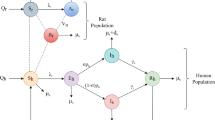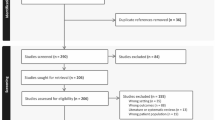Abstract
Nutrition plays a critical role in care, support and treatment of HIV infected individuals. In this paper, an HIV/AIDS mathematical model that incorporates supplementary feeding is formulated and analysed using the system of ordinary differential equations. The model has two equilibria, the disease-free equilibrium and endemic equilibrium. Analytical analysis of the model shows that the disease-free and endemic equilibria are globally stable for \(R_0<1\) and \(R_0>1\) respectively. Numerical simulations are done to show the role of some key model parameters as well as to verify some analytical results. The results of the study show that supplementary feeding taken concurrently with antiretroviral treatment can control the HIV/AIDS transmission by reducing the reproduction number thus leading to the disease control.







Similar content being viewed by others
References
UNAIDS.: 2017 \(|\) Reference UNAIDS Data. http://www.unaids.org/sites/default/files/media_asset/20170720_Data_book_2017_en.pdf (2017). Accessed 21 Aug 2017
Government of Malawi.: Global AIDS Response Progress Report (GARPR): Malawi Progress Report for 2013. http://files.unaids.org/en/dataanalysis/knowyourresponse/countryprogressreports/2014countries/MWI_narrative_report_2014.pdf (2014). Accessed 7 Sept 2017
National Statistical Office (NSO) [Malawi] and ICF.: Malawi Demographic and Health Survey 2015–2016, Zomba, Malawi, and Rockville, Maryland, USA. NSO and ICF. http://www.nsomalawi.mw/images/stories/data_on_line/demography/mdhs2015_16/MDHS 2015-16 Final Report.pdf (2017). Accessed 21 Aug 2017
Malvy, E., Thiébaut, R., Marimoutou, C., Dabis, F.: Groupe d’Epidemiologie Clinique du Sida en Aquitaine, Weight Loss and Body Mass Index as Predictors of HIV Disease Progression to AIDS in Adults. Aquitaine cohort, France, 1985–1997. J. Am. Coll. Nutr. 20, 609–615 (2001)
UNAIDS Policy Brief \(|\) HIV.: Food Security and Nutrition. http://www.unaids.org/sites/default/files/media_asset/jc1565_policy_brief_nutrition_long_en_1.pdf. Accessed 13 Sept 2017
Mangili, A., Murman, D.H., Zampini, A.M., Wanke, C.A.: Nutrition and HIV infection: review of weight loss and wasting in the era of highly active antiretroviral therapy from the nutrition for healthy living cohort. Clin. Infect. Dis. 42, 836–842 (2006)
Ivers, L.C., Cullen, K.A., Freedberg, K.A., Block, S., Coates, J., Webb, P.: HIV/AIDS, undernutrition and food insecurity. Clin. Infect. Dis. 49, 1096–1102 (2009). https://doi.org/10.1086/605573
Piwoz, E.G., Preble, E.A.: HIV/AIDS and Nutrition: A Review of the Literature and Recommendations for Nutritional Care and Support in Sub-Saharan Africa, Washington, D.C. Academy for Educational Development, SARA Project. USAID: Washington DC (2000)
Olsen, M.F., Abdissa, A., Kæstel, P., Tesfaye, M., Yilma, D., Girma, T., Wells, J.C.K., Ritz, C., Mølgaard, C., Michaelsen, K.F., Zerfu, D., Brage, S., Andersen, A.B., Friis, H.: Effects of nutritional supplementation for HIV patients starting antiretroviral treatment: randomised controlled trial in Ethiopia. BMJ. (2014). https://doi.org/10.1136/bmj.g3187
Bisika, T., Mandere, G.: Integration of nutrition in the antiretroviral therapy scale up plan for Malawi. Malawi Med. J. 20, 93–98 (2008)
Zachariah, R., Fitzgerald, M., Massaquoi, M., Pasulani, O., Arnould, L., Makombe, S., Harries, A.D.: Risk factors for high early mortality in patients on antiretroviral treatment in a rural district of Malawi. AIDS 20, 2355–2360 (2006)
Semba, R.D., Tang, A.M.: Micronutrients and the pathogenesis of human immunodeficiency virus infection. Br. J. Nutr. 81, 181–189 (1999)
HIV/AIDS.: A Guide For Nutrition, Care and Support. Food and Nutrition Technical Assistance Project. Academy for Education Development, Washington DC. http://apps.who.int/disasters/repo/8518.pdf (2001). Accessed 13 Sept 2017
Ockenga, J., Grimble, R., Jonkers-Schuitema, C., Macallan, D., Melchior, J.C., Sauerwein, H.P., Schwenk, A., Süttmann, U.: ESPEN guidelines on enteral nutrition: wasting in HIV and other chronic infectious diseases. Clin. Nutr. 25, 319–329 (2006)
Hove-Musekwa, S.D., Nyabadza, F.: The dynamics of an HIV/AIDS model with screened disease carriers. Comput. Math. Methods Med. 10, 287–305 (2009). https://doi.org/10.1080/17486700802653917
Huo, H.F., Chen, R., Wang, X.Y.: Modelling and stability of HIV/AIDS epidemic model with treatment. Appl. Math. Model. 40, 6550–6559 (2016). https://doi.org/10.1016/j.apm.2016.01.054
Tripathi, A., Naresh, R., Sharma, D.: Modelling the effect of screening of unaware infectives on the spread of HIV infection. Appl. Math. Comput. 184, 1053–1068 (2007). https://doi.org/10.1016/j.amc.2006.07.007
Cai, L., Li, X., Ghosh, M., Guo, B.: Stability analysis of an HIV/AIDS epidemic model with treatment. J. Comput. Appl. Math. 229, 313–323 (2009). https://doi.org/10.1016/j.cam.2008.10.067
Hethcote, H.W.: The mathematics of infectious diseases. SIAM Rev. 42, 599–653 (2000)
van den Driessche, P., Watmough, J.: Reproduction numbers and sub-threshold endemic equilibria for compartmental models of disease transmission. Math. Biosci. 180, 29–48 (2002)
Salle, J.L., Lefschetz, S.: Stability by Liapunov’s Direct Method with Applications. Academic Press, New York (1961)
McCluskey, C.C.: Lyapunov functions for tuberculosis models with fast and slow progression. Math. Biosci. Eng. 3, 603–614 (2006)
Nyabadza, F., Mukandavire, Z., Hove-Musekwa, S.D.: Modelling the HIV/AIDS epidemic trends in South Africa: insights from a simple mathematical model. Nonlinear Anal. Real World Appl. 12, 2091–2104 (2011). https://doi.org/10.1016/j.nonrwa.2010.12.024
National Statistical Office.: Government of Malawi. Malawi in figures 2016. Zomba. http://www.nsomalawi.mw/images/stories/data_on_line/general/malawi_in_figures/Malawi in Figures 2016(1).pdf (2016). Accessed 20 Mar 2018
UNAIDS.: Country factsheets. Malawi \(|\). http://www.unaids.org/en/regionscountries/countries/malawi (2016). Accessed 20 Mar 2018
Chitnis, N., Hyman, J.M., Cushing, J.M.: Determing important parameters in the spread of malaria through the sensitivity analysis of a mathematical model. Bull. Math. Biol. 70, 1272–1296 (2008)
Nyabadza, F., Mukandavire, Z.: Modelling HIV/AIDS in the presence of an HIV testing and screening campaign. J. Theor. Biol. 280, 167–179 (2011)
Baryarama, F., Mugisha, J.Y.T., Luboobi, L.S.: A mathematical model for the dynamics of HIV/AIDS with gradual behaviour change. Comput. Math. Methods Med. 7, 15–26 (2006)
Colecraft, E.: HIV/AIDS: nutritional implications and impact on human development. Proc. Nutr. Soc. 67, 109–113 (2008). https://doi.org/10.1017/S0029665108006095
Acknowledgements
Farai Nyabadza would like to thank support of the Department of Mathematical Sciences at Stellenbosch University, in the production of this manuscript. Symon Chibaya acknowledges with gratitudes financial support from the Department of Human Resource Management and Development (Malawi) and Malawi University of Science and Technology.
Author information
Authors and Affiliations
Corresponding author
Additional information
Publisher's Note
Springer Nature remains neutral with regard to jurisdictional claims in published maps and institutional affiliations.
Appendix: Analysis of the Reproduction Number
Appendix: Analysis of the Reproduction Number
Recall that
and
A back substitution gives
The terms in (A1) can be explained as follows
-
\(\frac{1}{\mu +q_1+\sigma _1}, \frac{1}{\mu +q_2+\sigma _2}, \frac{1}{\mu +\gamma +\sigma _3} \) and \(\frac{1}{\mu +\delta }\) are the average times an individual spends in the infected class I, the treated class \(T_n,\) the supplementary feeding class \(T_s\) and the AIDS class A respectively.
-
\(\frac{q_1}{\mu +q_1+\sigma _1}\) is the proportion of individuals who seek treatment and progress from compartment I to compartment \(T_n.\)
-
\(\frac{q_2}{\mu +q_2+\sigma _2}\) is the proportion of individuals who progress from compartment \(T_n\) to compartment \(T_s.\)
-
\(\frac{\sigma _1}{\mu +q_1+\sigma _1}, \frac{\sigma _2}{\mu +q_2+\sigma _2}\) and \(\frac{\sigma _3}{\mu +\gamma +\sigma _3}\) are the proportions of individuals who develop AIDS from compartments I, \(T_n\) and \(T_s\) respectively.
-
\(\frac{q_1}{\mu +q_1+\sigma _1}\times \frac{\sigma _2}{\mu +q_2+\sigma _2}\) is the proportion of individuals who develop AIDS from compartment \(T_n\) having come from compartment I.
-
\(\frac{q_1}{\mu +q_1+\sigma _1}\times \frac{q_2}{\mu +q_2+\sigma _2}\) is the proportion of individuals who progress to compartment \(T_s\) from compartment \(T_n\) having come from compartment I.
-
\(\frac{q_1}{\mu +q_1+\sigma _1}\times \frac{q_2}{\mu +q_2+\sigma _2}\times \frac{\sigma _3}{\mu +\gamma +\sigma _3}\) is the proportion of individuals who develop AIDS having started in compartment I via compartments \(T_n\) and \(T_s\).
\(R_I\) is the reproduction number due to infectives, I, \(R_{T_n}\) is the reproduction number due to treated, \(T_n\), \(R_{T_s}\) is the reproduction number due to feeding supplement, \(T_s\) and \(R_A\) is the reproduction number due to AIDS, A.
Rights and permissions
About this article
Cite this article
Chibaya, S.B., Nyabadza, F. Mathematical Modelling of the Potential Role of Supplementary Feeding for People Living with HIV/AIDS. Int. J. Appl. Comput. Math 5, 97 (2019). https://doi.org/10.1007/s40819-019-0660-9
Published:
DOI: https://doi.org/10.1007/s40819-019-0660-9




